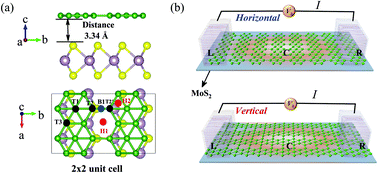Highly anisotropic gas sensing of atom-thin borophene: a first-principles study†
Abstract
Two-dimensional (2D) materials have promising applications in ultra-sensitive gas molecule detection owing to their thinness. Among the atom-thin 2D crystals, graphene with a nearly isotropic 2D structure has been widely used in gas sensors. Here, we propose a gas sensor device structure with strongly anisotropic atom-thin β12 borophene on top of an MoS2 substrate for detecting inorganic small molecules in the environment. The electronic properties are systematically investigated to understand the interaction between the gas molecules and β12 borophene. Nonequilibrium Green's function is used to study the transport properties of β12 borophene on the MoS2 substrate for gas sensing. It is found that the gas sensing performance of β12 borophene is highly anisotropic, especially for NH3 that has the largest anisotropic gas sensing ratio of 17.43. Such a highly anisotropic gas sensing ratio could be utilized to realize the detection of specific gas molecules with strong tolerance to errors due to device and environmental fluctuations. Our results suggest the promising application of highly anisotropic atom-thin 2D crystals for error tolerance gas sensors.



 Please wait while we load your content...
Please wait while we load your content...